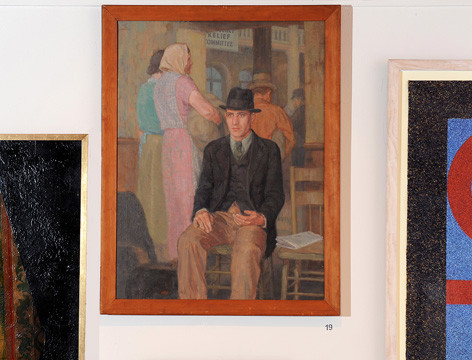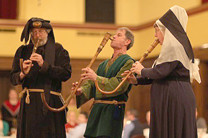
5:10 p.m., by American artist Lynn Stacey, will be part of an exhibition opening Jan. 10 in the Brunnier Art Museum that contrasts the pre-1929 salon style of exhibiting art (seemingly random placement of art stacked floor to ceiling) with the modern linear presentation style. 5:10 p.m. is a retrieved painting once on University Museums' "lost art" list. Photo by Bob Elbert.
As part of efforts to catalog the public works of art on campus for an upcoming publication, University Museums staff seeks the university community's help in locating an estimated 40 original 2-D pieces. The works of art are listed in a 1940s art inventory, but museums staff have little information on most of them -- and no images on which to base their search.
There are other difficulties as well, according to museums director Lynette Pohlman. Some buildings on the inventory list don't exist anymore, and some departments have changed location or scope. Works of art may have migrated to storage closets when new occupants didn't enjoy them or perceived them to be "out of style," she said. Some were given away as retirement gifts despite being state property.
"If you work on campus, we encourage you to look in closets and niches of your department or office. If you find something that looks like art, but you don't have any specifics on it, please call us [4-3342]," Pohlman said. "We're trying to rediscover Iowa State's cultural heritage. That's what's in those closets."
Pohlman said facilities and asset recovery staff and faculty members have been helpful in alerting her when they came upon abandoned pieces or others in deep storage over the years. The most recent find occurred the week after fall commencement. A custodian reported a work of art was by the dumpster on the Atanasoff Hall loading dock. It turned out to be a print purchased in the 1930-40s from the original art inventory.
Art collector since the 1920s
Iowa State's original College Art Committee was created in 1927 by president Raymond Hughes. Over the next two decades, the committee acquired, primarily through purchases, more than 600 originals and reproductions to exhibit in campus buildings. This early collection contained many quality reproductions of famous works from artists such as Rembrandt, Van Gough and Cezanne. It also included limited edition Depression Era prints, original works by Iowa and regional artists and from the Midwest Public Works of Art Project, and donations from the Ella Rodgers Hughes (President Hughes' wife) collection. Pohlman said the committee kept good track of the college's art collection until World War II, when the nation's focus shifted to science and technology.
In the 1980s, University Museums began caring for all of the works of art across campus. Museums staff have an inventory of what they could find.
Pohlman said she's especially interested in locating another dozen easel-sized murals the college purchased during the Great Depression from the Grant Wood Studio Mural Workshop (five have been found), as well as any faculty portraits commissioned during the 1930s and 1940s (there were dozens).
"I realize people may not recognize the person in a portrait, or maybe it's just not their taste in art," Pohlman said. "Collectively, these pieces are a living memory of Iowa State University."

